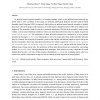11428 search results - page 2267 / 2286 » Learning From Crowds |
JSAC
2007
13 years 8 months ago
2007
— One of the distinctive features in a wireless ad hoc network is lack of any central controller or single point of authority, in which each node/link then makes its own decision...
JSS
2007
13 years 8 months ago
2007
Without rigorous software development and maintenance, software tends to lose its original architectural structure and become difficult to understand and modify. ArchJava, a recen...
ARTMED
2002
13 years 8 months ago
2002
Present-day healthcare witnesses a growing demand for coordination of patient care. Coordination is needed especially in those cases in which hospitals have structured healthcare ...
ARTMED
2002
13 years 8 months ago
2002
An artificial neural network ensemble is a learning paradigm where several artificial neural networks are jointly used to solve a problem. In this paper, an automatic pathological...
COGSCI
2004
13 years 8 months ago
2004
Disfluencies include editing terms such as uh and um as well as repeats and revisions. Little is known about how disfluencies are processed, and there has been next to no research...

